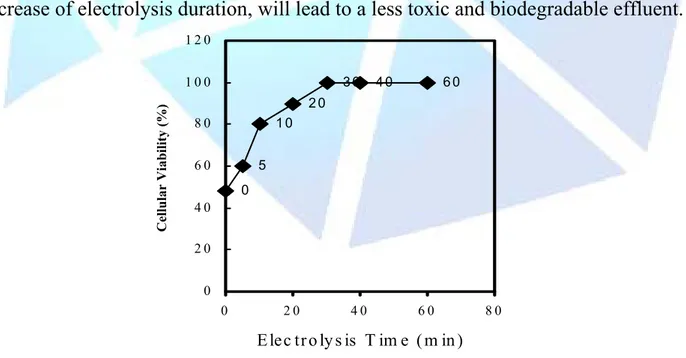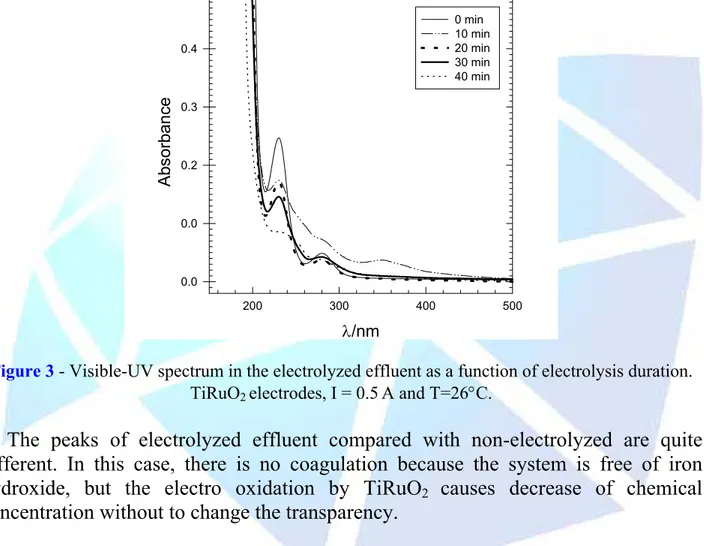ELECTROCHEMICAL TREATMENT OF CHEMICAL INDUSTRY WASTEWATER USING STEEL AND TIRUO2 ELECTRODES
Texto
(2) Recebido em: 27/09/2004 Liberado para Publicação em: 30/03/2006. HOLOS Environment, v.6 n.1, 2006 - P. 2 ISSN: 1519-8634. persistent molecules, normally, found in wastewater of rubber chemical industry and, turn then biocompatible to the environment. Key words: wastes pollutant, electrodes biodegradation, electrolytic process, persistent molecules.. 1. INTRODUCTION The concern regarding conservation of the environment has lead to great interest for environmental technology in using the water and energy resource. This interest seeks the materials recycling, reduction of water consumption and the reduction of conventional treatment costs (ARCHIBALD et al., 1998). The electrolytic system has shown to be efficient as an alternative form to the treatment of different types of industrial effluents (TOLENTINO e BIDOIA, 2000). This treatment has much versatility (DE LEVIE, 1999; SCHILLER e BIDOIA, 2000). Therefore it reduces toxicity by breaking recalcitrant substances, such as: aromatic rings, in biodegradable products. Thus, the electrolytic treatment, as pre-treatment, increases the efficiency of the conventional biological processes (INAZAKI et al., 2002). The cost to set up a wastewater treatment system is directly proportional to the variety of toxic substances that should be removed. In general, many of the wastewaters contain recalcitrant organic compounds (WEBER, 1999). The electrolytic process produces electrooxidation of the organic substances. Thus, it is not necessary the use of oxidant chemical products in the process (BRATFICH et al., 1999). Also, it promotes the coagulation and flocculation processes, as well as it allows the treated wastewater to be recycled. This process is compatible with environmental standards (RÉGIS e BIDOIA, 2001). Therefore, the reactions during the effluent treatment will indicate the appropriate material to be used as electrodes (SMITH, 1972). This work aims to monitor molecular transformation during the electrolytic process applied to the effluent of a chemical industry. The effluent consists of antioxidants and antiozonants (RÉGIS e BIDOIA, 2002). 2. MATERIAL AND METHODS The electrolytic treatment has been applied in the effluent of a rubber chemical industry aiming to transform the recalcitrant molecules in the effluent in more biodegradable ones. The effluent contains a high content of organic material, such as aromatic amine: n-phenyl-n-isopropyl-p-phenylenediamine (brand name is Flexzone.
(3) Recebido em: 27/09/2004 Liberado para Publicação em: 30/03/2006. HOLOS Environment, v.6 n.1, 2006 - P. 3 ISSN: 1519-8634. 3P); n-phenyl-n’-1,3-butyldimethyl-p-phenylenediamine (brand name Flexzone 7P), ketones, oils and greases that are toxic material and extremely waste pollutants. The electrodes (MORAES et al., 2000) were two titanium metal plates (0.1 cm thickness, total geometric area of 8.0 cm2 each plate) spaced 0.5 cm apart, covered by a mixture of TiO2 and RuO2. The formula to prepare the TiRuO2 electrodes is described in an expired patent, currently available as public domain (DE NORA, 1970). The steel electrodes (SAE 1020 from Usiminas Co. – Brazil) used contains six plates with geometric area of 475 cm2 and spaced among them by 0.1 mm. They have thickness of 3 mm. Each test consisted of 50 mL volume of raw industrial effluent electrolyzed with a 0.5A direct current and the potential varies in the range of 7.0 to 8.0 V. The current was applied by a power supply (Dawer DC, model FCC-3005D) and the effluent was under agitation at room temperature conditions. After different electrolysis durations (0, 10, 20, 30 and 40 min), the chemical industry effluent has been analyzed by a visible-UV method to determine the molecular changes in the wastewater by peak shifting showed in a spectrum obtained from a visible-UV spectrophotometer Shimadzu, model 2401 PC. The cellular viability was made using a tube test containing Saccharomyces cerevisae suspension. The S. cerevisae suspension was put in contact with the effluent after being electrolyzed and the viable and the died cells were counted using a Neubauer glass slide (RÉGIS e BIDOIA, 2001). 3. RESULTS AND DISCUSSION 3.1. Steel Electrodes Figure 1 shows visible-UV Spectrum after electrolysis of raw effluent, using steel electrodes, under 0, 10, 20, 30 and 40 min duration. It appears a peak about 290 nm after electrolysis signalizing that molecules were transformed. The absorbance increases after electrolysis due to the coagulation by iron hydroxide. After the coagulation the raw effluent turns more transparent and the absorbance increases..
(4) HOLOS Environment, v.6 n.1, 2006 - P. 4 ISSN: 1519-8634. Recebido em: 27/09/2004 Liberado para Publicação em: 30/03/2006. 0 min 10 min 20 min 30 min 40 min. Absorbance. 3. 2. 1. 0. 200. 300. 400. 500. 600. 700. 800. λ/nm. Figure 1 - Visible-UV spectrum in the electrolyzed raw effluent as a function of electrolysis duration. Steel electrodes, I = 0.5 A and T=26°C.. Figure 2 shows the microorganism cellular viability (%) for Saccharomyces cerevisiae, on function of electrolysis duration, using steel electrodes. Thus, the increase of electrolysis duration, will lead to a less toxic and biodegradable effluent. 120 30. Cellular Viability (%). 100. 40. 60. 20 10. 80 5. 60 0 40 20 0 0. 20. 40. 60. 80. E lec tr o ly s is T im e ( m in ). Figure 2 - Representation of the cellular viability (%) for Saccharomyces cerevisiae on function of electrolysis duration. Steel electrodes, I = 0.5 A and T=26°C..
(5) HOLOS Environment, v.6 n.1, 2006 - P. 5 ISSN: 1519-8634. Recebido em: 27/09/2004 Liberado para Publicação em: 30/03/2006. 3.2. TiRuO2 Electrodes Visible-UV Spectrum made with effluent after electrolysis using TiRuO2 electrodes shows more intensive peak changes. After 20 min of electrolysis, it has been observed (see Figure 3), that the substances found in the effluent were deeply modified, once the shift in the peaks in the spectrum has occurred as well as the peak intensity. In this case, the electrodes of TiRuO2 did not promote a coagulation of substances, but it increases eletrooxidation. 0.5 0 min 10 min 20 min 30 min 40 min. Absorbance. 0.4. 0.3. 0.2. 0.0. 0.0 200. 300. 400. 500. λ/nm. Figure 3 - Visible-UV spectrum in the electrolyzed effluent as a function of electrolysis duration. TiRuO2 electrodes, I = 0.5 A and T=26°C.. The peaks of electrolyzed effluent compared with non-electrolyzed are quite different. In this case, there is no coagulation because the system is free of iron hydroxide, but the electro oxidation by TiRuO2 causes decrease of chemical concentration without to change the transparency. 4. CONCLUSIONS • Visible-UV Spectrum of electrolyzed raw industrial effluent, with TiRuO2 electrodes, has shown more intensive changes in peaks than electrolyzed effluents with steel electrodes; • The electrolytic process is an efficient method to modify persistent molecules found in rubber chemical industry effluent;.
(6) HOLOS Environment, v.6 n.1, 2006 - P. 6 ISSN: 1519-8634. Recebido em: 27/09/2004 Liberado para Publicação em: 30/03/2006. • Increase in the cellular viability of S. cerevisiae after electrolysis with steel electrodes, which infers to a decrease in toxicity levels after the related treatment; • As for as chemical substances have not been added to the final effluent during treatment and it has been shown that biodegradation can be reached, the related treatment is biocompatible to environmental requirements. 5. ACKNOWLEDGEMENTS This work was financially supported by CAPES (Brazil). 6. REFERENCES ARCHIBALD, F.; ROY-ARCAND, L.; METHOT, M.; VALEANU, L. Recalcitrant organic compounds (chemical oxygen demand sources) in biologically treated pulp and paper mill effluents: their fate and environmental impact in receiving water. Water Environment Research, Alexandria, v.70, n.7, p. 1314-1325, 1998. BRATIFICH, O. J.; DOMINGOS, R. N.; ANGELIS, D. F.; BIDOIA, E.D. Electrolysis of cell suspensions of bacillus subtilis (ATCC 9372) and of Saccharomyces cerevisiae (Fleischmann Royal) using cast-iron electrodes. Brazilian Journal of Ecology, Rio Claro, v. 3, n.2, p. 83 – 84, 1999. COMNINELLIS, C.; NERINI, A. Anodic oxidation of phenol in the presence of NaCl for wastewater treatment. Journal of Applied Electrochemistry, v. 25, n. 1, p. 23-28, 1995. DE LEVIE, R. The electrolysis of water. Journal of Electro-analytical Chemistry, v. 476, p.92-93, 1999. DE NORA, V. British Patent, v. 1, 231:280; 235, 570.1970. INAZAKI, T. H.; PIÃO, A. C. S.; BIDOIA, E. D. Effluent treatment contained nphenil-n.1.3-butyldimetyl-p-phenilenodiamine substances using electrolysis system. Arq. Inst. Biol., São Paulo, v. 69, p. 150-152 (supplement), 2002. MORAES, P. B.; CORSO, C. R.; BIDOIA, E. D. Electrochemical treatment of oil refinery wastewater using TiRuO2 electrodes. International Water Conference (IWC) Pittsburgh, p.13-16, 2000..
(7) Recebido em: 27/09/2004 Liberado para Publicação em: 30/03/2006. HOLOS Environment, v.6 n.1, 2006 - P. 7 ISSN: 1519-8634. RÉGIS, G.; BIDOIA, E. D. Toxicity comparison of chemical industry effluent after electrolytic process carried out with steel and Ti/TiRuO2 electrodes, uses the Saccharomyces cerevisiae as a biologic indicator. Arq. Inst. Biol., São Paulo, v. 69, p.153-155, (supplement), 2002. RÉGIS, G.; BIDOIA, E. D. Effluent treatment of a chemical industry through the electrolytic process aiming at reducing of the toxicity, monitored for the biologic indicator Saccharomyces cerevisiae. Revista Salusvita, v. 20, n. 3, p. 43-60, 2001. SCHILLER, W. R.; BIDOIA, E. D. Inhibition of hifas de Aspergillus to niger (Iz-9) for the electrolytic process using steel electrodes. Arq. Inst. Biol., Sao Paulo, v. 67, p. 74, (supplement) 2000. SMITH, E. C. Waste water treatment through electrochemistry. Applications of New Concepts of Physical-Chemical Wastewater Treatment, September, p.18 – 22, 32534, 1972. TOLENTINO-BISNETO, R.; BIDOIA, E. D. Water disinfections of supplying carried out with electrodes of carbon, steel, titanium and TiRuO2. Arq. Inst. Biol., São Paulo, v. 67, p. 77, (supplement), 2000. WEBER, T. J. Wastewater Treatment. Metal Finishing, v. 97, Issue: 1, 801-818, 1999..
(8)
Imagem


Documentos relacionados
The corrosion inhibition of mild steel in 1.0 M HCl solution by CBIPM was studied using common electrochemical techniques coupled with UV-vis spectroscopic and quantum chemical
Possíveis causas deste resultado são: (i) o menor aporte térmico ao se soldar com o eletrodo AWS E6010, que fez com que a taxa de resfriamento das soldas fosse maior e isso levou
The optimization of parameters for treating dairy industry effluent by electrocoagulation using aluminum electrodes showed that electric current application for 21 minutes,
O presente estudo teve como objetivo avaliar os diagnósticos de enfermagem mais frequentes em um grupo de clientes com classificações muito urgente e emergente atendidos
An electrocoagulation reactor with aluminum and iron electrodes was used to treat water from the treatment plant of the Research Center for Wastewater Treatment and Hazardous
Firstly, students should figure out the feasibility of a leveraged buyout on Alliance Boots and the motivations of Stefano Pessina; the discussion then evolves to a valuation
clara impossibilidade da evocação do mito sebastianista, colocando as personagens (e também o leitor) de frente com a realidade. No entanto, a desordem social não é apresentada